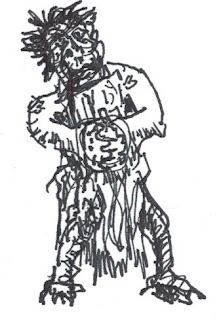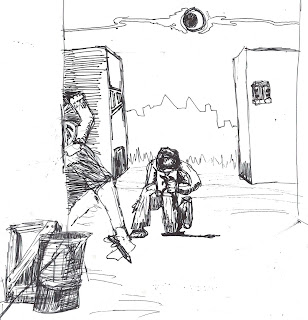Monday, July 25, 2016
Bryce Lynch's Adventure Design Tips Summarized and Explained (Mark 2)
What follows is a second attempt to briefly encapsulate the tips and principles for designing adventures presented by the inestimable Bryce Lynch in his singularly fantastic adventure review blog, Ten Foot Pole. This is basically the same as my previous postsummarizing the principles from Bryce's reviews of The Hoard of the Dragon Queen and The Rise of Tiamat, but with some minor edits to improve the felicity of expression (ahem).
Summarized and Explained
1. General Tips: The 5 C’s
1. Color: The referee should give brief but evocative descriptions of locations, monsters, NPCs, and treasures. Avoid the vague or generic.
2. Context: In order for their actions to be significant and purposeful, players must generally have some information about the likely consequences of their actions, such as likely reactions of monsters or NPCs.
3. Choice: There should be more than one course of action available to players in order for the adventure to continue. Avoid choke points—both literal choke points in the physical layouts of dungeons and other locations, and figurative choke points which require a unique decision or solution in order for the adventure to proceed.
4. Consequences: Player actions should be allowed to make a real difference in the adventure and in the campaign. Avoid a set storyline or sequence of events immune to player interference.
5. Creativity: Related to (3) and (4), reward player creativity by allowing them to pursue unanticipated courses of action or to produce unanticipated consequences, rather than restricting player action and player creativity by setting up arbitrary constraints in the location layout or course of events.
2. Hooks
6. Don’t rely on a single hook; use multiple kinds (treasure; reward; magic; glory; political power).
7. Create a rumor table with hooks and color.
8. Hooks should appeal to the players, not just to their characters.
9. Hooks can and should be complex or nuanced, such as working for an evil NPC or working for rival factions.
10. To support sandbox play, dungeon, town, and wilderness locations, monsters, and NPCs should all have hooks.
3. Locations (Dungeons, Towns, Wilderness, etc.)
11. Location descriptions should be terse (not verbose) but evocative (not boring, obvious, or generic).
12. Only include background info that affects gameplay; avoid long descriptions of irrelevant info.
13. Rooms should have features that players can interact with to produce meaningful consequences. Give concrete descriptions of secret doors, traps, etc.
14. Floor plan tips:
a. Multiple routes (vs. choke points or linear, one-way paths).
b. Multiple entrances and exits.
c. Multiple stairs per floor.
d. Open spaces with balconies, galleries, and ledges at various elevations.
e. Pools and rivers that connect different rooms or levels.
f. Bridges and ladders.
4. Monsters and NPCs
15. Create interesting, believable motivations for monsters and NPCs.
16. Create factions of monsters and NPCs, which leads to a dynamic, interconnected strategic situation.
17. Give players the choice of allying with, attacking, trading with, or having other relationships with monsters and NPCs.
18. Create schedules, routines, tactics, or orders of battle for monsters and NPCs.
19. Wandering monsters too should be given motives, goals, hooks, and tactics.
20. Avoid standard monsters. Failing that, describe standard monsters in a non-standard way (e.g., don’t just name the species).
21. Give evocative descriptions of monsters. Give concrete descriptions of their appearance and activities. Go for the telltale sensory detail, rather than the generic abstract trait. Show, don’t tell.
Example: Instead of stating “One of the guards in the camp is a cruel bully,” say “The burly Manfred takes a leak on Tobias’s bedroll, and then snatches Tobias’s roasted chicken from his hand and quickly gobbles it down.”
22. Use truly evil monsters to evoke a Sense of Terror.
5. Treasure
23. Treasure should be valuable enough to motivate players and to make the challenges worthwhile.
24. Non-magical treasure should relate to the setting and give clues or information about monsters, NPCs, locations, etc.
25. Avoid standard magic items.
26. Give evocative descriptions of magic items. Give concrete descriptions of their appearance and how they must be manipulated to produce their magical effects.
27. Use magic items to evoke a Sense of Wonder.
6. Format and Functionality
28. Include reference tables:
a. Rumor/hook table.
b. Monster/NPC table that lists their main traits, motivations, location, etc.
c. Room/building table that lists the rooms in a dungeon or other keyed location.
29. In published modules, put maps and monster stats on separate sheets so they are easy to refer to in play.
30. On maps, use keyed symbols to indicate standard features (e.g., lit/unlit, locked/unlocked, secret, trapped, etc.), rather than a verbal description in the location key.















